Day 3: A riot, a parade, and a sexy woman
We woke up at a relatively decent hour and once again had a light breakfast. The fear of altitude sickness continued to loom in the air like some unseen specter threatening to pounce. Unseen, except to those who were already feeling queasy. Coca tea for everyone!
We had the morning to ourselves to explore the city so everyone went their own way to do whatever sightseeing, shopping, and general absorption of the local color they could. Simon, Shannon and I headed to one of the many internet cafés to check if there was any word about our step brother (Simon’s brother) Danny who couldn’t make the trip due to a public speaking competition. It was too bad he couldn’t make it with us, but it later turned out he won the national championship and $16,000. So now I can say I knew him before he was famous. Guess I should get that autograph before the prices go through the roof.
While Shannon and Simon got set up in the café, I stepped out to find an ATM and get some money changed. Since I had given all of my money to the little girl and her mob in the half charity/ half confidence scheme the day before, I was completely cleaned out and how could I possibly survive in the mean streets of Cusco without the means to purchase small trinkets or other pieces of tourist-targeted native craft? This time I was going to get a decent amount changed and pay attention to what exactly each coin meant.
But the challenge of deciphering the denominations of the sol would have to wait while I dealt with the challenge of even finding an ATM in the first place. I soon found myself completely and utterly lost in the busy Monday morning traffic in the streets of Cusco. There was an entirely different feel in the air because the street vendors were not as prevalent, but the streets were packed to the gills with cars. No one ever stops for pedestrians here, but instead they honk their horns and flash their lights. The worst offenders are the taxi cabs, but you have to wonder how much business they could get from a pedestrian pinned to the ground by their front tires. Some of the vendors mentioned the day before that they would not be around during the week since Sunday is the only day the police aren’t out. That did sound ludicrous, but then there was an obviously heavier police presence on the street Monday morning.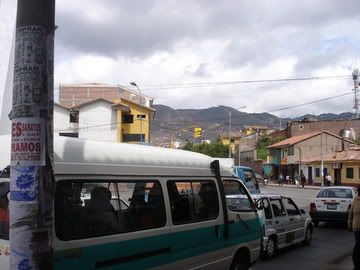
The crazy Cusco traffic
I came to a busy traffic circle where the maddening fray was as mad as ever. There were crosswalks painted on the ground, but they may as well have not even been there since no one stops at those either. A cop was directing the flow of traffic in the circle – but he was doing so from the curb on the far side. He blew his whistle as hard as his little lungs would let him, but he was clearly not getting any closer to the mayhem then he absolutely had to.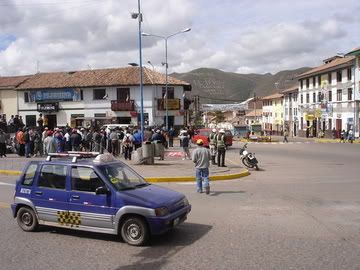
Traffic circle of death. The cop is cowering off screen to the right
By this point I realized I wasn’t going to find my way back anytime soon, so I immersed myself in the city and just wandered in whichever direction seemed appropriate. I discovered that you can learn so much more about what a place is actually like by just wandering around and letting yourself be absorbed by your surroundings. This is a city just like any other and everyone has their shopping, their cleaning, and their work to do just like anywhere else. There are just a lot more feral dogs here. After receiving several offers to have my shoes repaired and then shined (how you would go about shining a pair of grungy tennis shoes is beyond me), I found the ATM I had been so desperately seeking and filled my pockets with precious soles. It also happened to be on the corner of a street that led to the Plaza de Armas so I headed over to do some shopping for myself.
I came across a store that was selling interesting rings. I spoke with the woman and learned the that they depict the Inca’s Triologia which consists of the serpent, representing the world of darkness, the puma, representing the world we live in now, and the condor, representing the world of spirits. The connection between these, as we would learn later, is that when you die, the puma either carries your spirit to the serpent or the condor, depending on how you acted in your lifetime. And this came before the Catholics, so I guess the Incas had their way of guilting their congregations into lives of tithing and self-denial as well. I was moved by the history behind the images so I bought one of them off of her. This incident was the first where my Spanish truly turned out to be an amazing asset, since otherwise I would have an interesting ring of Peruvian silver but would have no clue about the deep and spiritual meaning behind the characters on it.
By now I had been gone from the internet café for well over an hour and since I had said I would just be a minute, I figured it was probably time to head back and show I wasn’t dead at the hands of some crazy taxi. The problem remained, however, that I had no idea what any of the streets were or where they led, and an even bigger problem that surfaced was that I had no idea what the hotel we were staying at was called. Let this be a lesson children: never wander the streets of a remote third-world city without at least having some sort of clue as to where your suitcase might be. Just as I was preparing to begin my new life as an adopted citizen of Cusco, fated never to leave, I found the traffic circle with the frightened cop. I couldn’t find the café again, but I did make it back to the hotel where Shannon and Simon were now standing in the lobby. After the warm greetings of “Where the hell have you been?” Shannon told me that I had been gone so long, there was now somewhat of an informal search going on. This is what happens when we have no access to cellphones.
Now reunited, Shannon, Simon and I walked back to the Plaza to meet Dad and Barbara. At this point a tremendous crowd was gathering on the steps of the cathedral and around the park at the center of the square. We couldn’t tell at all what the fuss was all about and the sign over the little pavilion that had been set up on top of the steps only said “City of Cusco” and “Cusco is number one.” This may be true, but it certainly doesn’t answer any questions about why everyone was abandoning their jobs to hang out in front of the church. Some kid selling paintings and making it abundantly clear he wanted to go to the U.S. mentioned something about a festival, but we were too busy running away to really catch what he was saying.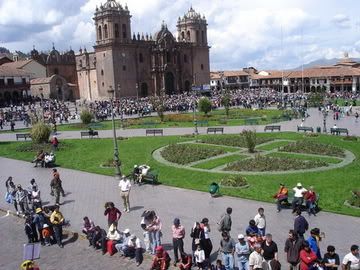
The crowd gathers - but why?
Dad and Barbara came along and we went into an alcove by the Plaza’s secondary cathedral which turned out to be a large store for local vendors. They were selling the typical finger puppets, gourds and hats, along with some other interesting crafts, but without the aggression you would find on the streets. Back on the square the crowd had now grown even larger and groups of people dressed in colorful costumes were building up in the backstreets. Some woman came up to us and quickly pinned little ribbons on us. Thankfully she had good aim - I wasn't looking for an impromptu Peruvian surgery. Upon further inspection, there appeared to be large troupes of people performing dances in traditional attire. Like a parade, each group had a sign out front and they were all lined up, ready to march into the streets. But just as everything was starting up, a large group of picketers came from another side street and beat them to the punch. It was hard to tell anything from their signs except that they were from some union, and if unions are good at anything, it would be picketing. This was an excellent opportunity to see not only the nitty-gritty of local politics, but also to see how Peruvian riot police dress and operate. How can you say you’ve seen a place until you’ve seen its forms of severe maintaining the peace?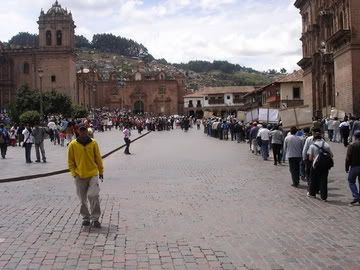
The picket line hits the square
The riot police hit the picket line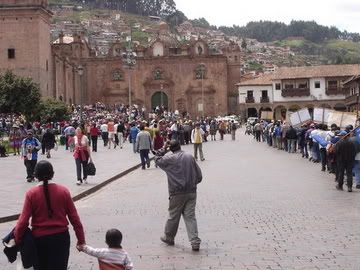
Confusion hits the people
We returned to the hotel to meet up with our guide and then bussed back to the square for lunch in an upstairs café. Our guide finally explained what all the hubbub was about. The mayor of Cusco had constructed a large commercial center near the entrance of the city where local street vendors could go and set up shop. This took a great deal of people off the street and gave the vendors a place they could call home and peddle their wares with greater success. Because of this, the vendors from the center had gotten together to put on a thank you parade for the mayor on his birthday. The costumes and dances were representative of the native areas of the vendors who were performing, showing just how very rich the culture is throughout Peru. Fortunately the restaurant was right above the street so we had a perfect view of all the costumes and dances.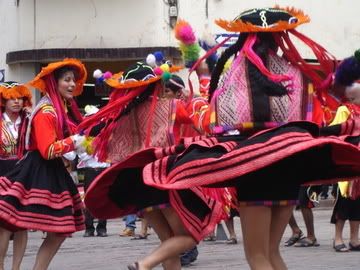
Dancers practicing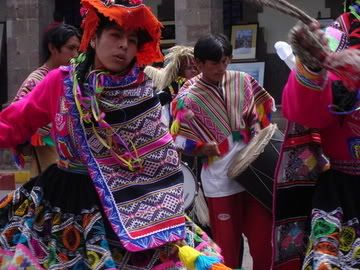
A woman does her twirls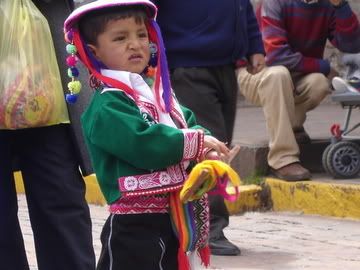
"I knew I shouldn't have eaten that"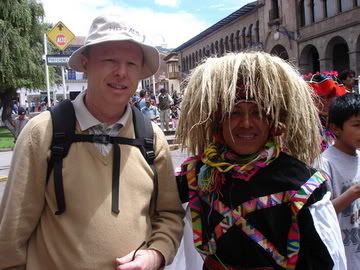
Dad and hairy hat man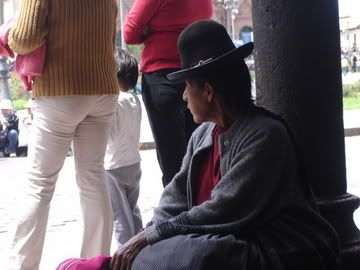
A local woman observes the festivities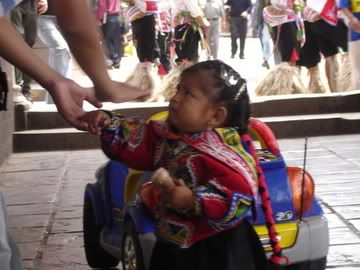
Little girl and her dad
After lunch we boarded a larger tour bus with another group of people to hop around the city and learn about the Inca history there. First we toured the Coriancha which was a massive temple built by Pachaputec to honor the sun. This is a prime example of an ancient Inca structure that the Spanish decided to “improve” by building their cathedral and Spanish style architecture on top of the old foundation. It’s a truly magnificent building, but there is a feeling that the history you’re observing and learning about isn’t the real history at all. The museum of Spanish Catholic robes and icons is not very moving, considering a highly talented and broad race of people had to be wiped out to make it happen. There are pictures, though, of how after earthquakes the relatively hi-tech Spanish construction collapsed while the primitive and mortar-less Inca foundation remained. That image will never cease to amaze me.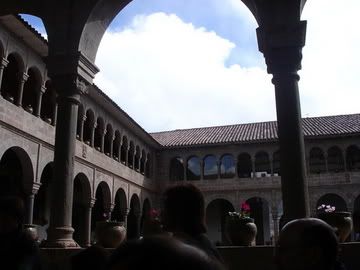
Inside the Coriancha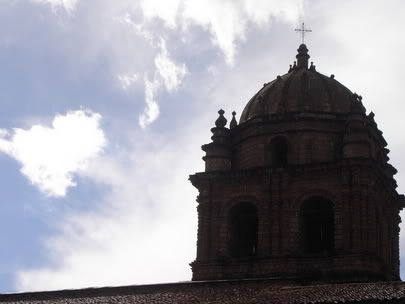
The tower of the Coriancha
The next stop was the main cathedral in the Plaza de Armas. Again, the Spanish raised the Inca’s palace in order to build this house of God. In an interesting twist of irony, however, it took longer to construct this one cathedral than it took the Incas to build all of Machu Picchu. There’s food for thought. It is unfortunate that you can’t take pictures inside the cathedral because it is really quite a sight to see. Everything is lined with gold (presumably gold that was stolen from the Incas anyhow) and there are hundreds of paintings everywhere. A good deal of them were painted by a local artist in Cusco which means that many traditional Christian images are portrayed through the eyes of the Andean faith. People of power are depicted with angular flowing gowns that make them look like mountains, the significance being that the Incas worshipped the mountains so anyone of importance should look like one. Another painting had pictures of camels, but since the Peruvians had never seen a camel before (they didn’t even have horses until the Spanish came), the animals strangely resembled llamas. But the most fascinating image was that of the last supper with Jesus and the apostles feasting on the local dish cuy, or guinea pig. Who knew that Jesus had a penchant for the exotic, even up until the end?
We boarded the bus and headed into the hills above the city to see the ruins of Saqsaywaman, or “sexy woman” as the guide pointed out to help us remember. Throughout the trip it became more and more apparent that that is a joke the guides often use with the English tourists. I bet they never get tired of us bastardizing their history and heritage. This site looks kind of like the field where you find Stonehenge in that it is long plains of green with stones scattered throughout. It was at one point a large Inca city, but the Spanish mined the stones like a quarry for their own construction. Yet even with all the weather, earthquakes, and human meddling, you can see the stones are lined up perfectly. Even when there is a small gap between two uneven rocks, a perfectly shaped tiny rock is fit into the hole. From on top of this mountain you can look down into Cusco and it is a truly a majestic sight. It was becoming easier and easier to understand why the Incas had selected this place as the cradle of their faith.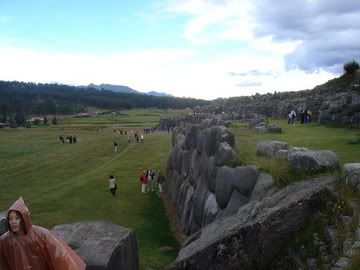
The plains of Saqsaywaman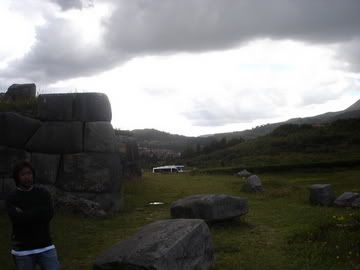
The stones are lined up perfectly with no mortar - yet still they stand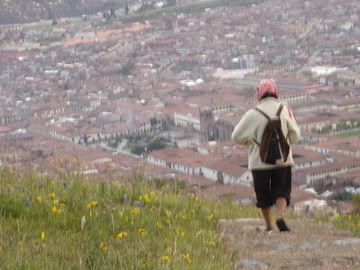
Heading down the road to Cusco
The tour continued to a water temple which doubled as a routing plant for a spring in the mountain and then to a rock with a tunnel carved in it and a sacrificial altar in the center. It’s too bad the Incas didn’t use writing because the history of these places would be a truly fascinating tale.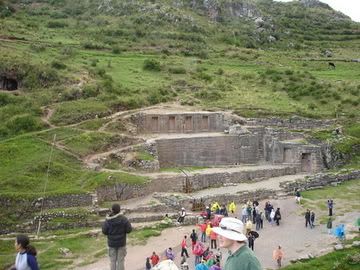
The water temple
Water continues to run from the spring through the Inca structure
On our way back down the mountain, we stopped at an alpaca factory where we were assured we’d find much higher quality clothing than anywhere down in the city. I’m sure the guide gets his pocket lined quite nicely for bussing susceptible tourists into this trap. They had all kinds of things ranging from what you might find in the town to more elaborate and finely woven garments. The woman at the shop showed us a vicuna scarf which is incredibly soft and ridiculously expensive. Vicunas are an endangered species that resemble llamas and alpacas, but their softness and scarcity drive the prices of their wool to roughly $1500 per pound. The question arises: why don’t we all have vicuna farms?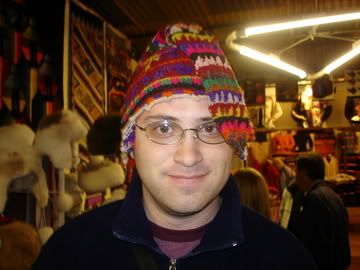
What a lovely alpaca hat - perfect for proms and weddings
While all this was happening, Simon had been speaking to a boy standing out front of the shop with his alpaca, charging for pictures. Simon was practicing his Spanish with the boy and learning a bit about what he and his family did. He asked the boy if the alpaca belonged to his family, but instead it came out more as is the alpaca in your family. The boy sharply responded “No. It is an animal.” Tough crowd.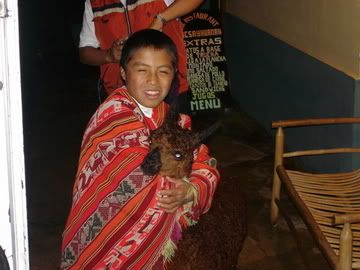
A boy and his alpaca...not to be trifled with
Once back in the hotel we met our guide for the trek, Marilu, to get the briefing on just what exactly we had waiting for us in the next few days. She showed us maps of the trail and gave us a general overview of where we would hike each day, what we would see, and where we would camp. The gist of it was the first day would be easy and level, the second day we would hike over the highest peak on the trek and then come down a bit, the third day we would hike mainly level until we descended, and the last day would be a short jaunt to Machu Picchu. It would later turn out that this description of the trail was complete bunk and it was infinitely harder than she ever let on. You’ll see why as we go.
Everything was fine, though, until she double checked that we had our backpacks to carry our sleeping bags and mats and everything. The fact was, we didn’t. We had been told by the travel agent to pack a duffel bag weighing no more than 15 kilos for each person, which the porters on the trail would carry. We would only be responsible for a day pack containing whatever rain coats, water, snacks, emergency flares and last rite prayer books we would require. There was certainly no room for the sleeping bags and mats. What were we going to do? Stress struck the group as we looked a very potential disaster in the face. Finally Marilu agreed that we could fit two people in each duffel bag and the porters would carry those. We would just have to carry the duffel bags through the control points ourselves so the officials wouldn’t see we were loading the porters up well past the legal weight limit.
After the discussion, everyone was pretty much pooped, so the only people to go to our planned dinner show that night were me, Dad, Barbara, Shannon and Simon. It turned out dinner was at a very touristy restaurant where the tables had flags from the home country of whoever was eating there. There were an awful lot of Japanese flags spread throughout. The food was sort of a smorgasbord of various countries, but we did get the opportunity to taste cuy. It’s very bony and quite unpleasant. I think I’ll just keep my guinea pigs as pets for now.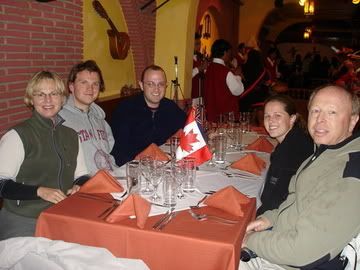
The gang in the trap - we're smiling so it's clearly before the cuy
After having our ears blasted by the performers, who happened to be right next to our table, we headed back to the hotel and repacked everything into the duffel bags to meet the new requirements. Things seemed to be off to an inauspicious start and everyone was rather at wits end. We needed to get some rest because the next day we would be starting our incredible journey deep into the heart of the Andean wilderness…in search of Machu Picchu.


